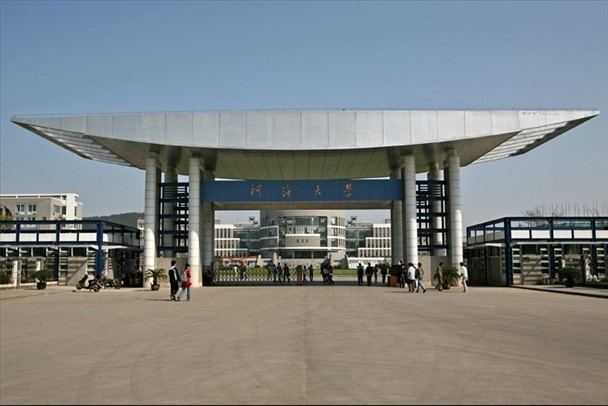Chairman Prof. Tang Hongwu Phone +86 25 5809 9483 Motto 艰苦朴素,实事求是,严格要求,勇于探索 | Established 1915 President Prof. Xu Hui Total enrollment 30,000 (2005) Founded 1915 | |
 | ||
Former names East China Technical University Of Water Resources Undergraduate tuition and fees International tuition: 25,000 CNY (2010) Similar Southeast University, Nanjing University of Scienc, Nanjing Agricultural University, Nanjing University of Aerona, Nanjing Normal University | ||
Hohai university jiangning campus nanjing china 20140420 144848
Hohai University (Chinese: 河海大学) is a research university in Nanjing, China under the direct jurisdiction of the Ministry of Education of China. From 1958 to 2000 it was administered by the Ministry of Water Resources.
Contents
- Hohai university jiangning campus nanjing china 20140420 144848
- Propaganda of hohai university
- History
- Campuses and facilities
- Colleges and schools
- Staff and students
- Research
- Cooperation and development
- International cooperation
- References
The university's main focus is the research and study of water resources, and it primarily educates engineering subjects, with coordinated development of engineering, science, economics, management, arts and law. It is part of Project 211 (a development initiative by the Chinese government involving over 100 key universities) and has set up a graduate school.
Propaganda of hohai university
History
Hohai Civil Engineering School was founded in 1915. Later it was merged with the Department of Engineering of National Southeastern University and became Hohai College of Engineering in 1924. It was incorporated into the Dyisyi Chungshan University, becoming the Department of Water Resources, of later National Central University in 1928.
With the establishment of the People’s Republic of China in 1949, it became the Department of Water Resources, Nanjing University. In 1952 the Departments of Water Conservancy, Hydrology, and Water Resources of Nanjing University, Jiaotong University, Tongji University, Zhejiang University and the East China Engineering School of Water Resources were merged into the East China Technical University of Water Resources. In 1985 it became what it is named today, the Hohai University, under the authority of Deng Xiaoping.
Campuses and facilities
Hohai University has three campuses, occupying a total of 132 hectares (326 acres). The main campus, covering 45 hectares (111 acres), is located at the northern foot of Qingliang Hill in Nanjing. With green shade trees, fragrant flowers in four seasons and an elegant environment, it is one of the 300 Best Green Campuses, and has won Jiangsu Provincial Award of Garden University. A secondary campus was established in February 1986 in Changzhou, a city between Shanghai and Nanjing. Fully equipped, it occupies an area of 30 hectares in the High-Tech Development Zone of Changzhou. A third campus, comprising 57.6 hectares (142 acres) in Jiangning Economic Development Zone of Jiangning District, Nanjing, began operations in September 2001.
Hohai Library consists of three libraries in three campuses with a total area of 47,000 square meters. It has more than 1.85 million books, including 120,000 Chinese and English periodicals, with 567,000 electronic books (including a CD database). Hohai University provides internet service all day.
Students can find classrooms, dining halls, shopping centers, entertainment center, gym, and swimming pool on campus.
Colleges and schools
Hohai University consists of the following colleges and schools:
It has nine state and provincial key laboratories and five state and provincial engineering research centers. There are three state key disciplines, eight provincial and ministerial key disciplines, five post-doctorate mobile stations, 33 Ph.D. programs, 73 Master's programs, 18 Engineering Master's programs and MBA, and 46 undergraduate programs.
Staff and students
There were over 30,000 degree studentss enrolled at the university in 2005, of which 7,143 were Master and Ph.D. candidates and 18,648 undergraduate students. There are over 3,000 staff members, including one academician of both the Chinese Academy of Engineering and the Chinese Academy of Sciences, one academician of the Chinese Academy of Engineering, 796 professors and associate professors, and 167 doctor's supervisors. Ten academicians are employed as adjunct professors and supervisors for Ph.D. students.
Research
The university has undertaken tasks and research projects for the Chinese government. Such programs include:
The university has been involved in large projects concerning water conservancy and hydropower, for instance:
It has been involved in large traffic engineering construction projects such as:
Hohai University has won 262 prizes for scientific research work, including 19 state prizes and 185 ministerial and provincial prizes since 1995. More than 11,822 dissertations have been published in academic publications and conferences at home and abroad, over 245 scientific monographs have been printed, and nearly 94 patents has been conferred.
Cooperation and development
Hohai Cooperation and Development Committee was founded in December 2001 in response to the needs for economic construction and social development, to deepen the strength and extent of higher education serving economic construction, and to expand the channels of social participation in running a school.
The former Vice President of the Chinese People's Political Consultative Conference and the first president of the East China Technical University of Water Resources, Ms. Qian Zhengying, participated in the inaugural meeting and was elected the Honorary President of the Committee. 24 big names and scholars became commissioners. The 120 unit commissioners are from many enterprises and institutions of the government at all levels, such as departments of water conservancy, electrical power, traffic, environmental protection, education, finance, and army.
International cooperation
Hohai, with its international exchange and cooperation arrangements, was one of the first universities entitled by the State Council to confer the degrees of Doctor, Master and Bachelor upon overseas students. It has trained hundreds of Doctors, Masters and bachelor's degree students for overseas countries and districts, and has established inter-universities cooperative relationships with nearly 50 universities from more than 20 countries and districts.
